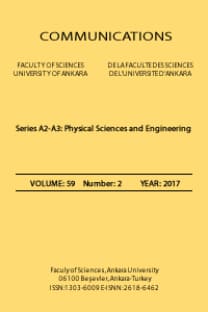EVALUATION OF MS-DIAL AND MZMINE2 SOFTWARES FOR CLINICAL LIPIDOMICS ANALYSIS
Lipidomics, Bioinformatics, MS-Dial, MZmine2
___
Kim, M., Rai, N., Zorraquino, V., Tagkopoulos I., Multi-omics integration accurately predicts cellular state in unexplored conditions for Escherichia coli, Nat Commun. 7 (2016), 13090-96.Wilson, B.J., Nicholls, S.G., The Human Genome Project, and recent advances in personalized genomics, Risk Manag Healthc Policy, 8 (2015), 9-20.
Du, F., Zou, Y., Hu, Q., Zhang, H., Ye, D., Comparative transcriptomic analysis reveals molecular processes involved in pileus morphogenesis in Pleurotus eryngii under different light conditions, Genomics, 2019.
Ahmed, F., Kumar, G., Soliman, F.M., Adly, M.A., Soliman, H.A.M., El-Matbouli, M., et al., Proteomics for understanding pathogenesis, immune modulation and host pathogen interactions in aquaculture, Comp Biochem Physiol Part D Genomics Proteomics, 32 (2019), 100625.
Jia, H., Wang L, Li, J., Sun, P., Lu, M., Hu J., Comparative metabolomics analysis reveals different metabolic responses to drought in tolerant and susceptible poplar species, Physiol Plant, 2019.
Lydic, TA, Goo, Y.H., Lipidomics unveils the complexity of the lipidome in metabolic diseases, Clin Transl Med., 7 (2018), 4-17.
Rupasinghe, T.W., Lipidomics: extraction protocols for biological matrices. Methods Mol Biol. 1055 (2013) 71-80.
Hu T, Zhang, JL., Mass-spectrometry-based lipidomics. J Sep Sci. 41 (2018) 351-72.
Hsu FF. Mass spectrometry-based shotgun lipidomics-a critical review from the technical point of view, Anal Bioanal Chem., 410 (2018), 6387-409.
Loizides-Mangold, U., On the future of mass-spectrometry-based lipidomics, FEBS J., 280 (2013), 2817-29.
Kyle JE, Crowell KL, Casey CP, Fujimoto GM, Kim S, Dautel SE, et al. LIQUID: an-open source software for identifying lipids in LC-MS/MS-based lipidomics data. Bioinformatics. 33 (2017) 1744-6.
Zhou Z, Shen X, Chen X, Tu J, Xiong X, Zhu ZJ. LipidIMMS Analyzer: integrating multi-dimensional information to support lipid identification in ion mobility-mass spectrometry based lipidomics. Bioinformatics. 35 (2019) 698-700.
Zhou Z, Tu J, Xiong X, Shen X, Zhu ZJ. LipidCCS: Prediction of Collision Cross-Section Values for Lipids with High Precision To Support Ion Mobility-Mass Spectrometry-Based Lipidomics. Anal Chem. 89 (2017) 9559-66.
Yeo HC, Chen S, Ho YS, Lee DY. An LC-MS-based lipidomics pre-processing framework underpins rapid hypothesis generation towards CHO systems biotechnology. Metabolomics. 14 (2018) 98.
Tsugawa H, Cajka T, Kind T, Ma Y, Higgins B, Ikeda K, et al. MS-DIAL: data-independent MS/MS deconvolution for comprehensive metabolome analysis. Nat Methods. 12 (2015) 523-6.
Tsugawa H, Ikeda K, Tanaka W, Senoo Y, Arita M, Arita M. Comprehensive identification of sphingolipid species by in silico retention time and tandem mass spectral library. J Cheminform. (2017) 19.
Klatt S, Brammananth R, O'Callaghan S, Kouremenos KA, Tull D, Crellin PK, et al. Identification of novel lipid modifications and intermembrane dynamics in Corynebacterium glutamicum using high-resolution mass spectrometry, J Lipid Res. 59 (2018) 59 1190-204.
Pluskal T, Castillo S, Villar-Briones A, Oresic M. MZmine 2: modular framework for processing, visualizing, and analyzing mass spectrometry-based molecular profile data, BMC Bioinformatics, 11 (2010) 395.
- ISSN: 1303-6009
- Yayın Aralığı: Yılda 2 Sayı
- Başlangıç: 2019
- Yayıncı: Ankara Üniversitesi
AN ARTIFACT REDUCTION METHOD FOR BLOCK-BASED VIDEO CODING
Hakki Alparslan ILGIN, Ahmet AKBULUT
LEARNING DENSE CONTEXTUAL FEATURES FOR SEMANTIC SEGMENTATION
Hacer YALİM KELES, Long Ang LİM
A STUDY ON THE SEARCH POTENTIAL OF DOUBLY CHARGED LEPTONS AT THE SppC BASED ep COLLIDERS
Aysuhan OZANSOY, Oğuzhan ALBAYRAK
GENERATING TURKISH LYRICS WITH LONG SHORT TERM MEMORY
Mehmet GÜZEL, Hakan ERTEN, Erkan BOSTANCİ
RF ANTENNA DESIGN FOR BUTTON-TYPE BEAM POSITION MONITORS USING BIO-INSPIRED OPTIMIZATION METHODS
Ayhan AYDIN, Gazi Erkan BOSTANCI
BAND REDUCTION FOR TARGET DETECTION IN HYPERSPECTRAL IMAGES
Murat ŞİMŞEK, Hakki Alparslan ILGIN
THE DESIGN OF STANDALONE PV SYSTEM USING P&O ALGORITHM FOR MAXIMUM POWER POINT TRACKING
EVALUATION OF MS-DIAL AND MZMINE2 SOFTWARES FOR CLINICAL LIPIDOMICS ANALYSIS
THE DESIGN OF STANDALONE PV SYSTEM USING P&O ALGORITHM FOR MAXIMUM POWER POINT TRACKING
